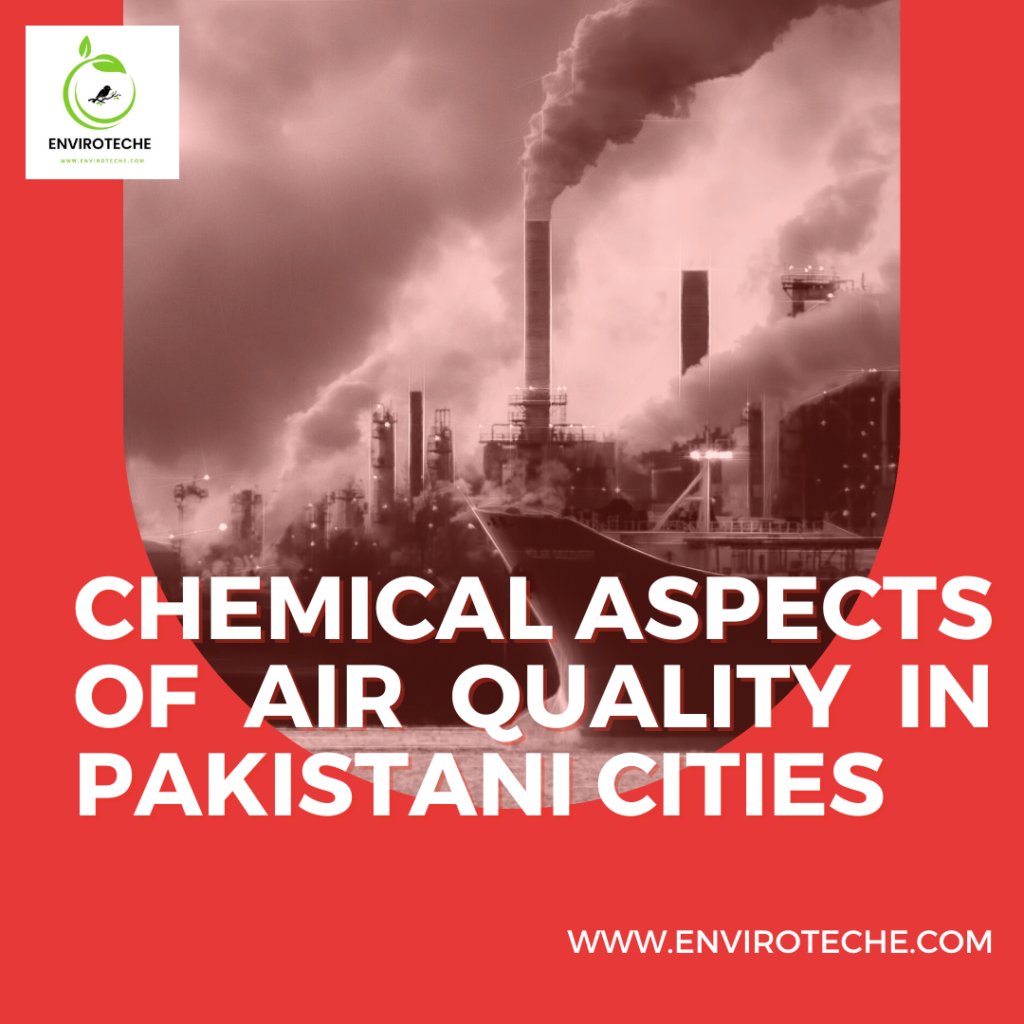Table of Contents

Air Quality in Pakistan
Underdeveloped nations like Pakistan have experienced significant increases in air pollution emission sources in recent decades due to fast industrial growth, urbanization, and consequently increased traffic volume. Significant human-caused factors, such as extensive construction projects and incomplete combustion from sources including industries, refineries, and wood burning, are also responsible for the sharp increase in urban particulate matter that enters (PM) emissions. Due to migration or natural growth, urban regions have seen skyrocketing population densities. This has led to an unprecedented increase in traffic and building activity, which has hurt the environment.
Air Pollution Features:
As a result, air pollution has become one of the biggest risks to urban ecosystems and quality of life. Pakistan’s aerosol mass concentrations (PM 2.5) are regularly much above the WHO and the country is ranked third in the world regarding deaths attributed to air pollution. Nevertheless, poor ground data and an insufficient number of air quality detection stations are prerequisites for regulation. In Pakistan, particulate pollution has become a major environmental health hazard. High concentrations of pollutants in the indoor environment are produced when biomass fuels are used in conventional stoves. In Pakistan, households that are 58% urban and 94% rural rely on biomass fuel.
Indoor and Outdoor Particle Pollution:
This study examines changes in particulate matter concentrations indoors and outdoors for three distinct micro environments in Pakistan during different activities. In kitchens employing biomass fuels at an agricultural site, that mean both indoor and outdoor proportions for PM10, PM2.5, & PM1 were 3.80, 4.36, & 4.11, respectively (Rashid et al., 2022). During cooking, a significant fluctuation in the mass percentage of dust particles was observed. The great majority of people in underdeveloped nations heat and cook with solid biomass fuels, which lowers indoor air quality.
What is Particulate Matter?.
Particulate matter consists of minuscule liquid or solid particles, so small that inhaling them can significantly harm one’s health. Particles measuring less than ten micrometers in diameter have the capacity to enter the bloodstream and deeply penetrate the lungs, posing a serious health risk.
Impact of Particulate Matter on Air Quality in Pakistan
Recently, there has been a worldwide trend of air pollution and the presence of particulate matter, leading to escalating health and socioeconomic risks. The effects of these risks are now increasingly noticeable, particularly in developing nations like Pakistan where there are insufficient systems in place for monitoring, alerts, or safety.
The severity of these challenges underscores the urgent need for comprehensive strategies to address air quality issues, safeguard public health, and mitigate the broader socio-economic consequences in vulnerable regions(Alvi et al., 2018). Numerous epidemiological studies have connected rising death rates and various health conditions with poor air quality. The death rates in Pakistan from exposure to elevated air pollution levels, particularly particulate matter, are concerning.
Urban Areas Affected by Air Pollution in Pakistan
The results show that the precise kind of pollutant taken into account and the metric employed have an impact on the pollution rankings of cities. For example, Jhang, Multan, and Vehari rank as the top three most polluted cities in Pakistan when Aqua Terra products are taken into account (Anjum et al., 2021). Leading cities in terms of PM1, PM2.5, and PM10 are Okara, Gujranwala, and Lahore.
The top three cities for tropospheric NO2 Vertical Column Density (VCD) are Islamabad, Rawalpindi, and Lahore. Lahore, Mirpur, and Gujranwala are the cities with the greatest levels of pollution for SO2 VCD, it is concluded. Pakistan’s annual average PM2.5 concentration from 2003 to 2022 was 54.7 μg/m3.
This implies that for a considerable amount of time, the general public has been exposed to continuously high levels of this particulate matter. Notably, this mean concentration is higher than both the WHO Interim Target-1, which suggests an annual mean PM2.5 concentration of less than 35 μg/m3, and the Pakistani Environmental Protection Agency’s (Pak-EPA) National Quality of the Environment Guidelines (Pak-NEQS), which specify an annual mean ambient air concentration of less than 15 μg/m3.
Parameters Affecting Air Quality in Pakistan
The Temporal analyses of aerosol and rare gas concentrations about night time lights, fire location data, surface types, and population density show that anthropogenic sources within Pakistan, as well as those from neighboring countries, have a significant impact on Pakistan’s air quality. Of the 80 Pakistani cities, statistically important positive (increasing) trends were found in PM1, PM2.5, PM10, tropospheric nitrogen dioxide (NO2) VCD, and SO2 VCD in approximately 89%, 67%, 48%, 91%, and 88% of the cities, respectively (Bajwa & Sheikh, 2023) .
Factors Affecting Air Quality in Urban Areas of Pakistan
Sources of air pollution in urban areas of Pakistan are vehicles, local businesses, heating and cooling equipment, wood fire, gas-powered yards, and recreational types of equipment.
Carbon monoxide (CO)
The incomplete burning of carbonaceous fuels, such as kerosene, charcoal, petrol, wood and natural gas, releases carbon monoxide into the environment. This gas is tasteless, colourless and odourless.
Ozone (O3)
A key constituent of photochemical smog is ground-level ozone, formed through reactions with gases under the influence of sunlight. It’s important to distinguish this from the ozone layer, which is situated in the stratosphere.
Nitrogen Dioxide (NO3)
Frequently emitted during the combustion of petroleum products in industrial and transportation sectors, nitrogen dioxide is a gas.
Sulfur Dioxide (SO2)
A colourless, pungent gas known as SO2 is released when fossil fuels like coal and oil are burned, as well as when sulfur-containing mineral ores are burned.
Factors Affecting Air Quality in Rural Areas of Pakistan
- Livestock
Carbon dioxide emissions are the main cause of pollution in the air and variations in global warming. Livestock is a vital component of agricultural productivity and the foundation of economic growth in any economy. The primary goal of the current analysis was to investigate how CO2 emissions affect Pakistani livestock production using annual data ranging from 1972 to 2019.
- Greenhouse gases
Greenhouse gases retain some heat in the atmosphere. The recent increase in greenhouse gas pollution is causing the climate to overheat because it traps more heat than it should. A few instances of air pollution are greenhouse gases like carbon dioxide (Colbeck et al., 2010).
- Fertilizers
Nutrients like phosphorus and nitrogen make up fertilizers. Stormwater carries these nutrients into the closest river, stream, or other body of water when it rains. An abundance of nutrients in the water can lead to the growth of algae, which depletes the amount of oxygen in the water’s surface. Overapplication of fertilizer results in emissions of oxides of nitrogen which pollute the air. There are certain pollutants in the atmosphere today.
Conclusion
Given the current situation, quick action is required to address the poor quality of the air. It is imperative to establish general air quality standards, expand the network of constant monitoring sites, and devise emission control strategies.
References
Alvi, M. U., Chishtie, F., Shahid, I., Mahmud, T., & Hussain, R. (2018). Traffic‐and Industry‐Related Air Pollution Exposure Assessment in an Asian Megacity. Clean–Soil, Air, Water, 46(1), 1600773.
Anjum, M. S., Ali, S. M., Subhani, M. A., Anwar, M. N., Nizami, A.-S., Ashraf, U., & Khokhar, M. F. (2021). An emerged challenge of air pollution and ever-increasing particulate matter in Pakistan; a critical review. Journal of Hazardous Materials, 402, 123943.
Bajwa, A. U., & Sheikh, H. A. (2023). Road Transport’s Contribution to Pakistan’s Air Pollutionin the Urban Environment. Air, 1(4), 237-257.
Colbeck, I., Nasir, Z. A., & Ali, Z. (2010). The state of ambient air quality in Pakistan—a review. Environmental Science and Pollution Research, 17, 49-63. Air Quality in Pakistan Air Quality in Pakistan Air Quality in Pakistan Air Quality in Pakistan Air Quality in Pakistan
Rashid, S., Shah, I. A., Tulcan, R. X. S., Rashid, W., & Sillanpaa, M. (2022). Contamination, exposure, and health risk assessment of Hg in Pakistan: A review. Environmental Pollution, 301, 118995. Air Quality in Pakistan Air Quality in Pakistan
Author detail:
Razia Yaseen, Aisha Ghaffar
Department of Chemistry, University Of Agriculture Faisalabad, Sub-Campus Toba Tek Singh
Check Other Scholarships:

